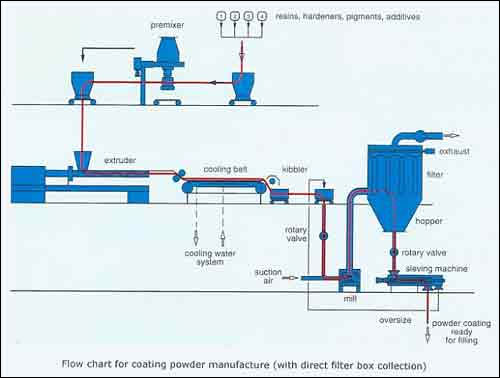Pigments are the coloring elements present in the paints and have a
very special place in the paint industry. The paint industry uses specialty
pigments to manufacture paints for a variety of applications. Ranging from
automobiles to buildings hardware, the list is virtually endless.
The paints that employ the wide variety of pigments can be broadly
classified according to application into two types. They are colorants for
the industrial applications and architectural/decorative applications
respectively. The diagram given below shows the process of use of Pigments
in manufacture of Powder Coatings:

Earth color Pigment- Derived from the
natural sources and are inorganic in nature (i.e. metal oxides). Examples:
ocher, umber, terra di siena, bolus, swedish red etc.
Earth pigments have properties like:-
- Lightfast
- Chemical
- Fast weather Resistant
Mineral Pigments- Mineral pigments comprises synthetic inorganic
pigments. Examples: chrome oxide green, titanium dioxide, iron oxide yellow,
red, brown and black, ultramarine blue, nickel-titanium yellow etc.
One of the disadvantages of mineral pigments is the toxicity and ecological
imbalance.
Plant Color Pigments- Plant colors are sourced from natural organic
pigment found in plants. Examples: indigo, alizarin red, woad, reseda,
alkanna violet and saffron.
Synthetic Pigments- Synthetic Pigments are the most widely used but
artificial organic pigments and dyes. Examples are: azo, dioxazine and
phthalocyanin.
The advantage is synthesization in almost any shade, especially in pure
color tones and gives dazzling visual effects.
More the amount of pigment and binder, better the
quality of the paint.
Paints are manufactured using 4 basic ingredient categories:
- Pigments
- Binders
- Liquids
- Additives

![]() Profile
Profile ![]() Product Range
Product Range![]() Industries
Industries![]() Infrastructure
Infrastructure![]() Our Quality
Our Quality![]() Custom Manufacturing
Custom Manufacturing![]() Network
Network![]() Contact Us
Contact Us![]() Send Enquiry
Send Enquiry


![]()

![]() Profile
Profile
![]() Product
Range
Product
Range![]() Industries
Industries![]() Infrastructure
Infrastructure![]() Our
Quality
Our
Quality![]() Custom
Manufacturing
Custom
Manufacturing![]() Network
Network![]() Contact
Us
Contact
Us![]() Send
Enquiry
Send
Enquiry